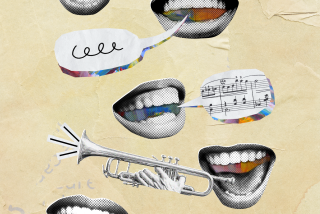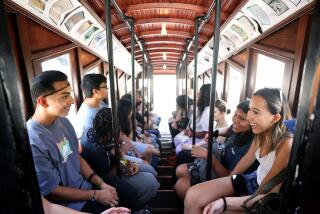Computers Help to Break Classroom Language Barriers : Education: A Macintosh program lets Spanish-speaking students learn at a higher level while developing English skills.
Blair High School ninth-grader Jose Lomeli electronically moved backward and forward between different computer “pages,” or screens, of his physical science project.
He had screens for ionic bonding, compounds and covalent bonding. He illustrated the project’s text with sketches, such as one of battling dinosaurs that he had drawn with a graphics program.
“The first time, I thought this program was difficult,” he said in Spanish. That was about four months ago. “Little by little, I noticed it was easy.”
The 14-year-old from Mexico is learning English, but he’s already fluent in HyperCard, a language of Apple Computer Inc.
He’s among dozens of Spanish-speaking students taking part in a program in which non-English speakers use advanced computer technology to complete high-level course work while learning English.
The program, which utilizes Macintosh computers, was developed by Blair resource teacher Rich Miyagawa. Educators familiar with his work say his project gives these students educational resources that had been available only to English-speaking students. The program has earned a California Department of Education award.
“Our thrust is to seamlessly blend technology and curriculum,” Miyagawa said. “We’ve got something that is really powerful.”
After seeing Miyagawa’s presentation at a recent national bilingual-education conference in Washington, Des Plaines, Ill., educator Judy Kwiat arranged for Miyagawa to fly to Illinois. That state also has a large non-English-speaking population, mostly Latinos living in the Chicago area.
“Language-minority kids need all of the sophistication that kids in the mainstream get, and there are very few materials,” said Kwiat, who coordinates bilingual-teacher training for Illinois.
“Unfortunately, much of the curriculum for bilingual students is . . . watered down and slower and really boring,” teaching English through phrases such as, “This is a table” rather than, “The sun is a star,” she said. By the time the students learn English, they have fallen behind in other subjects.
The resulting frustration accounts for at least part of the 40% Latino dropout rate nationwide, much higher than the rate for any other ethnic group, Kwiat said.
For years, computers have been used for language drills, but Miyagawa aims higher. His project is multimedia--integrating computers with laser discs, audio, slides, graphics and projectors.
The full setup costs about $30,000, but a school district can set up a class to perform the basic tricks with a $3,000 investment--provided the instructor knows how to use the equipment.
Educators often comment, “I’ve got computers, but I don’t know what to do with them,” Miyagawa said. He can show them the “Romeo and Juliet” program that he and colleagues created under the name EduTech Software. The program can be linked with a laser disc of Franco Zeffirelli’s film version of the Shakespeare play.
The student can watch or review portions of the play with the touch of a key, or see scenes involving specific characters. Questions and analysis appear at the touch of another key.
Students can listen to an audio translation in Spanish. There are three levels of difficulty to the questions, depending on the student’s English fluency.
Blair High School has a desperate need for such programs: One in four students speaks little or no English.
Unlike foreign-language texts or other materials, Miyagawa’s program can be quickly converted to accommodate other languages. About 30 languages are spoken in the Pasadena Unified School district.
All that’s required for conversion is a translator to record a new audio track on the computer.
At its best, the multimedia class helps keep foreign-language students in school by stimulating their interest, said Joan Bissell, a UC Irvine researcher who surveyed Latino children in Santa Ana. The pupils were using a bilingual science laser disc created by Optical Data Corp., a New Jersey firm.
After using the disc, more students agreed with the survey statements, “I would like to take more science classes,” and “I would like to be a scientist,” than did students taught without it.
“We have kids knocking on the doors during lunch, wanting to finish their projects,” Miyagawa said. “When you hear the knock on the door at lunchtime, you’re a success.”
More to Read
Sign up for Essential California
The most important California stories and recommendations in your inbox every morning.
You may occasionally receive promotional content from the Los Angeles Times.











